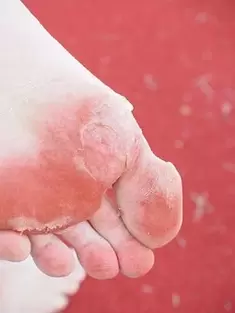Foot mycoses are the most common fungal skin infections today. There are three main types of foot mycosis, or fungus on the feet as they are also called. And each type is localized in different places on the foot and looks different.

How can you get athlete's foot?
Foot mycosis is caused by a fungus that grows on or in the top layer of the skin. The fungus thrives best in warm, humid locations. For example - in the area between the toes. Athlete's foot spreads very easily. It is enough to touch the fingers or toes of an infected person to be very likely to get sick as well. However, the most common fungal infection occurs when people walk barefoot on contaminated surfaces near swimming pools or in the changing rooms of the same pools, gyms, and similar objects. The fungus can then stay in your shoes, especially if the shoes are very tight and air cannot circulate around your feet.
If you touch an object with a fungus on it, you can then become a expeller and infect other people. Even if you infect others, it doesn't mean that you will definitely infect yourself. Doctors don't know why this happens, but everyone's predisposition to contracting fungal infections is different. And if you've already had mycosis, there is a high chance of getting infected again.
2. Symptoms of the fungus
The symptoms of foot mycosis can include burning and itching of the skin between the toes. The skin can peel and crack. Other symptoms of athlete's foot may differ depending on the athlete's foot diagnosed.
The first type is infection that most commonly causes symptoms between the fourth and fifth toes. The skin becomes flaky, flaky and cracked. In some cases, bacterial infection can join the mycosis and the skin condition worsens even more.
The second type of fungus is a disease that can begin with mild pain in the leg area. Then the skin on the heel or underside of the foot thickens and can tear. As the fungus progresses on the feet, it also affects the nails. In the case of nail fungus, it can thicken, break, or even fall out. Fungal infections on the nails and on the skin of the feet usually require different treatment.
Vesicular infection is the third type of athlete's foot. Typically, this type of athlete's foot begins with fluid-filled blisters under the skin. Blisters usually form on the bottom of the foot, but they can be found anywhere on the foot. This type of athlete's foot can also develop an accompanying bacterial infection.
3. Diagnosis of mycoses
To diagnose athlete's foot, a doctor usually only needs to examine the patient and study the medical history (symptoms, previous illnesses). If the fungus on your feet is unusual or doesn't respond to treatment, your doctor may take a sample of your skin or nail to test for fungus.
Not all foot skin problems are mycoses or athlete's foot. If you suspect you have a fungus but have never had one, it actually makes sense to see a good dermatologist.
4. Treatment of the disease
Special lotions, creams or sprays are usually sufficient to treat athlete's foot. In severe cases, your doctor may prescribe prescription pills or topical agents to treat toenail fungus. It is necessary to be treated for the fungus as much as the doctor says. This is a guarantee that it was really possible to completely cure the fungus. In addition to general foot mycosis treatment, it is imperative that the feet are clean and dry. The fungus needs warm, humid places to grow.
To prevent mycosis and the recurrence of athlete's foot, be sure to wear your own special shoes when visiting gyms, pools, and similar locations. To keep your feet dry, you can use talcum powder or special products. Sandals or shoes that are not too tight ensure adequate air circulation and moisture transport.


























